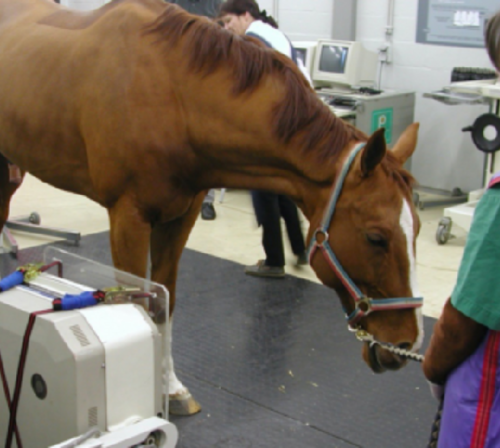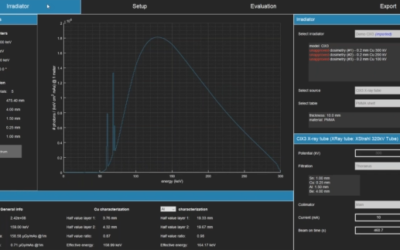
Wearing lead aprons reduces the exposure of veterinary surgeons and of helpers when performing equine bone scintigraphy. (Photo: Ghent University)
Published by the International Atomic Energy Agency
Animals, whether domesticated or wild, bring unique challenges to the field of radiation protection. Naturally, animals don’t tend to cooperate, and veterinary professionals need special techniques to assure clear medical imaging or effective treatment. Large species like horses, cows, lions and elephants require scaled-up equipment that use higher doses of radiation in conventional X ray procedures and computed tomography (CT) to achieve good imaging results. The newly released IAEA report No. 104 Radiation Protection and Safety in Veterinary Medicine from the Safety Report Series, provides advice for professionals in veterinary uses of radiation to help them safely carry out their work.
“There is a growth in veterinary medicine that mirrors the advancement in human applications that use radiation in medicine,” explained the guide’s technical secretary, IAEA Radiation Safety Specialist Debbie Gilley. “A recently observed trend is that more people are acquiring and taking care of animals, resulting in an increase in the use of radiation in veterinary medicine for animals, as they can undergo almost any procedure that is provided to people.”
The new publication provides much-needed radiation safety recommendations to veterinary practitioners and regulatory bodies and is relevant for academic educational programmes in veterinary medicine, professional bodies and suppliers of imaging and therapy equipment used in veterinary medicine. It helps professionals to strengthen radiation protection and safety in line with the technological advances made in the field of veterinary medicine, with clear methodology on the use of radionuclides for diagnosis and treatment in animal health care and the management of radiation exposure to workers and owners from the animal and the waste it produces, which may be radioactive for a short period of time.
“In a fragmented regulatory landscape with different training requirements, this document is a clear step forward in the harmonization of the use of radiation sources in veterinary medicine,” said Kathelijne Peremans, a European specialist in veterinary diagnostic imaging based at the Faculty of Veterinary Medicine at Ghent University, Belgium.
The call for this publication was first raised at an IAEA Radiation Safety Standards Committee (RASSC) meeting in 2017, attended by IAEA Member States and international bodies involved in developing and implementing radiation protection standards globally. They pointed to the proliferation of veterinary applications involving ionizing radiation over the past two decades.
“It is still common for veterinary practices to be considered under ‘industrial’ regulations rather than more appropriate ‘medical’ regulations. This guide will help regulatory bodies to better understand our practice and specifically adapt their recommendations to our field,” explained Jerome Benoit, a Radiation Oncology Specialist at Oncovet in France.
The guide is split into five main chapters that contain practical advice on radiation protection and safety in veterinary practices to workers, the public and the environment in radiology, nuclear medicine and radiotherapy. For example, the publication includes specific guidelines on the construction and shielding of rooms where radiation procedures are performed, choice of protective clothing for workers, management of radioactive contamination and the safe and secure storage of radioactive sources used for veterinary brachytherapy.
Jolien Berlamont, a nuclear inspector for the Federal Agency for Nuclear Control in Brussels said, “as a regulator, the safety report will help us to define the key elements for an effective radiation protection strategy, from stakeholders to training requirements and optimal facility layouts. It will also help us formulate the questions we need to ask as part of a clear inspection–surveillance strategy.”
The guide supports the IAEA Safety Standards in response to Articles III and VIII.C of its Statute: to make available and foster the exchange of information relating to peaceful nuclear activities and serve as an intermediary among its Member States for this purpose.
To find out more, watch the IAEA video on Radiation and Veterinary Medicine, filmed at the University of Veterinary Medicine in Vienna.
Download the Radiation Protection and Safety in Veterinary Medicine report here.







